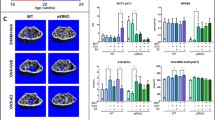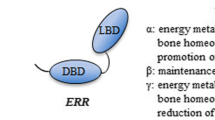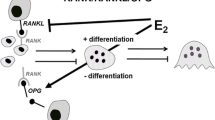Summary
Expression of isoforms of estrogen receptor (ER) was examined in the bone tissues. Reverse transcriptase-polymerase chain reaction (RT-PCR) using specific primers for rat ER cDNA was performed with total RNA from rat bone tissues. Then, we sequenced the amplified products after cloning and identified two isoforms of the ER and the wild-type ER. One of the ER mRNA isoforms did not have the region corresponding to exon 4 and the other isoform did not have the region corresponding to both exon 3 and exon 4. These isoforms were designated as ER Δ4 isoform and ER Δ3/4 isoform, respectively. The existence of these isoforms was also confirmed in ROS-17/2.8 osteoblastic osteosarcoma cells. Chloramphenicol acetyltransferase assay showed that these isoforms lost estrogen dependent transactivation activities. We suggest that the ER isoforms may play some roles in the bone metabolism in which estrogen is essential to maintain bone density.
Similar content being viewed by others
References
Riis BJ, Rodbro P, Christiansen C (1986) The role of serum concentrations of sex steroids and bone turnover in the development and occurrence of postmenoposal osteoporosis. Calcif Tissue Int 38: 318–322
Lufkin EG, Carpenter PC, Ory SJ, Malkasian GD, Edmonson JH (1988) Estrogen replacement therapy: Current recommendations. Mayo Clin Proc 63: 453–460
Gotfredsen A, Riis BJ, Christiansen C (1986) Total and local bone mineral during estrogen treatment: A placebo controlled trial. Bone Miner 1: 167–173
Eriksen EF, Corvald DS, Berg NJ, Graham ML, Mann KG, Spelsberg TC, Riggs BL (1988) Evidence of estrogen receptors in normal human osteoblast-like cells. Science 241: 84–86
Komm BS, Terpening CM, Benz DJ, Grahame KA, Gallegos A, Kore M, Greene GL, O'Malley BW, Haussler MR (1988) Estrogen binding, receptor mRNA, and biologic response in osteoblast-like osteosarcoma cells. Science 241: 81–84
Ikegami A, Inoue S, Hosoi T, Mizuno Y, Nakamura T, Ouchi Y, Orimo H (1993) Immunohistochemical detection and nothern blot analysis of estrogen receptor in osteoblastic cells. J Bone Miner Res 9: 1103–1109
Pensler JM, Radosevich JA, Higbee R, Langman CB (1990) Osteoclasts isolated from membranous bone in children exhibit nuclear estrogen and progesteron receptors. J Bone Miner Res 5: 797–802
Oursler MJ, Osdoby P, Pyfferoen J, Riggs BL, Spelsberg TC (1991) Avian osteoclasts as estrogen target cells. Proc Natl Acad Sci USA 88: 6613–6617
Korach KS (1994) Insights from the study of animals lacking functional estrogen receptor. Science 266: 1524–1527
Fuqua SAW, Fitzgerald SD, Chamnes GC, Tandon AK, McDonnell DP, Nawas Z, O'Malley BW, McGuire WL (1991) Variant human breast tumor estrogen receptor with constitutive transcriptional activity. Cancer Res 51: 105–109
Dotzlaw H, Alkhalaf M, Murphy LC (1992) Characterization of estrogen receptor variant mRNAs from human breast cancers. Mol Endcrinol 6: 773–785
Wang Y, Miksicek RJ (1991) Identification of a dominant negative form of the human estrogen receptor. Mol Endcrinol 5: 1707–1715
Skipper JK, Young LJ, Bergeron JM, Tetzlaff MT (1993) Identification of an isoform of the estrogen receptor messenger RNA lacking exon four present in the brain. Proc Natl Acad Sci USA 90: 7172–7175
Koike S, Sakai M, Muramatsu M (1987) Molecular cloning and characterization of rat estrogen receptor cDNA. Nucleic Acids Res 15: 2499–2513
Gubler V, Hoffman BJ (1983) A simple and very efficient method for cDNA libraries. Gene 25: 263–269
Ohara O, Dorit RL, Gilbelt W (1989) One sided polymerase chain reaction: The amplification of cDNA. Proc Natl Acad Sci USA 86: 5673–5677
Sanger F, Nicklen S, Coulson AR (1977) cDNA sequencing with chain terminal inhibitors. Proc Natl Acad Sci USA 74: 5463–5467
Takebe Y, Seiki M, Fujisawa JI, Hoy P, Yokote K, Arai KI, Yoshida M, Arai N (1988) SR alfa promoter an efficient and versatile mammalian cDNA expression system composed of the simian virus 40 early promoter and the R-U5 segment of human Tcell leukemia virus type 1 long terminal repeat: Mol Cell Biol 8: 466–472
Inoue S, Kondo S, Hashimoto M, Kondo T, Muramatsu M (1991) Isolation of estrogen receptor-binding sites in human genomic DNA. Nucleic Acids Res 19: 4091–4096
Graham FL, van der Eb AJ (1973) A new technique for the assay of infectivity of human adenovirus 5 DNA. Virology 52: 456–467
Smith EP, Boyd J, Frank GR, Takahashi H, Cohen RM, Specker B, Williams TC, Lubahn DB, Korach KS (1994) Estrogen resistance caused by a mutation in the estrogen-receptor gene in a man. N Engl J Med 331: 1056–1061
Author information
Authors and Affiliations
Rights and permissions
About this article
Cite this article
Hoshino, S., Inoue, S., Hosoi, T. et al. Demonstration of isoforms of the estrogen receptor in the bone tissues and in osteoblastic cells. Calcif Tissue Int 57, 466–468 (1995). https://doi.org/10.1007/BF00301952
Issue Date:
DOI: https://doi.org/10.1007/BF00301952




